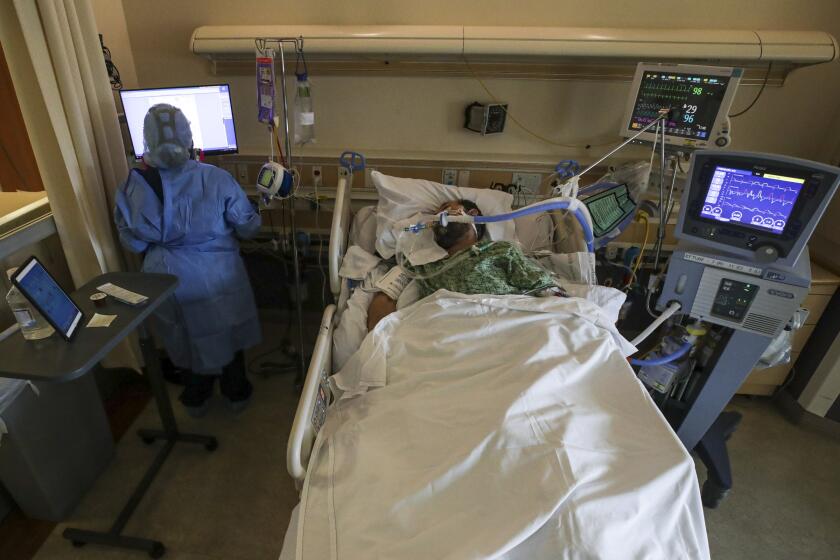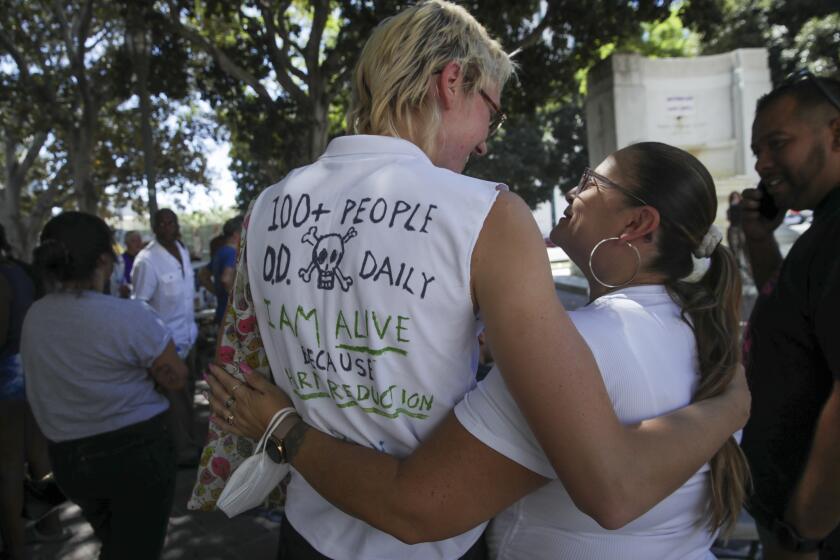Blacks’ Heart Disease Rates Tied to Artery Constriction : Health: Blood vessels return to normal size more slowly than in whites, study finds. It may lead to new treatments.
The first physical explanation of why African Americans are prone to high blood pressure, cardiovascular disease and strokes has been announced by researchers who say the findings may open the door to the development of new treatments.
University of Georgia scientists found that arteries from black patients with severe heart disease were unable to return quickly to normal size after they had constricted in response to stress or medications. This relaxation is impaired, they found, because cells lining the arteries do not produce chemicals that stimulate enlargement.
The sustained constriction increases blood pressure, places extra stress on the heart and increases the risk of a vessel rupturing, Dr. Randall Tackett reported Friday at the Ninth International Interdisciplinary Conference on Hypertension in Blacks, held in Cleveland.
Blacks have a 27% higher death rate from heart disease than whites and are twice as likely to die from stroke.
Tackett’s team made the discovery using leftover artery tissue from heart bypass recipients to test the arteries’ ability to relax. Similar, as yet unreported results from a team in New York that used a different technique support Tackett’s findings, suggesting that researchers may be well along the road to explaining the high rate of hypertension and related diseases in blacks.
As a result of Tackett’s findings, the researchers say they now will be able to test and develop medications to see which are most effective for blacks. And an understanding of the mechanism should make it possible to design highly specific new agents targeted at blacks’ hypertension, they added.
“This is a tantalizing, extremely interesting finding whose significance is in its promise” for drug development, said Dr. Stevo Julius of the University of Michigan. “But we cannot take it as a resolution of the issue,” he cautioned.
“This helps to explain a number of things that previously seemed unexplainable,” said Dr. Jan L. Houghton of the Albany Medical College in New York. In particular, she added, it shows that the high rate of hypertension and related disorders in blacks is “a public health problem, not just a sociological problem.” Some researchers have previously suggested that the susceptibility of blacks to the disorders is socioeconomic and cultural, reflecting lack of access to physicians, failure to take prescribed medicine and similar factors.
Although the difference in blood vessels between blacks and whites is most likely genetic in origin, Tackett said, “we can’t say that (this is proved by) our particular study at this point.”
Studying the problem in the laboratory has been extremely difficult because there are no animal models that distinguish between races, and ethical problems forbid most experimentation on humans.
“We spent two years identifying tissues that we could use in such studies,” Tackett said. “Our first idea was to use placental tissues from local hospitals,” but blood vessels in the placenta are different from those elsewhere in the body, he said. That would also exclude males from the study. Blood vessels from people killed in traffic accidents were also rejected because the tissues would deteriorate in the time required to procure them after death.
Vessels from coronary artery bypass operations, in which a blood vessel from the leg is used to replace clogged vessels near the heart, seemed like a good possibility. But the supply is limited because, as studies have documented, blacks have had much less access than whites to expensive procedures such as bypass surgery. Nevertheless, Tackett’s team found two cardiovascular surgeons in nearby Augusta whose patients included a large number of blacks. Because the operations are scheduled in advance, a team member could be present at the hospital for the surgery, collect the leftover tissue, and rush the 100 miles to their Georgia laboratory to perform tests.
They used tissue from 60 whites and 22 blacks.
In the tests, Tackett’s group exposed the artery tissue to a drug that caused it to constrict, then applied other drugs that would normally cause it to relax. Tissues from whites uniformly relaxed rapidly in response to the drugs, whereas those from blacks relaxed much less during the same period. With the drug acetylcholine, for example, blacks’ vessels became only 19% larger during the same time in which whites’ vessels became 34% larger.
Furthermore, biochemical tests showed that the impairment occurred because the cells that line the arteries of blacks could not release a chemical that normally promotes relaxation. That chemical, the gas nitric oxide, has recently been identified as a signaling agent throughout the body, released by one group of cells to tell others to carry out a specific function. In this case, nitric oxide secreted by the endothelial cells orders the blood vessels to relax.
Tackett’s findings have been confirmed by Albany’s Houghton, who normally performs cardiac catheterization--the insertion of diagnostic probes into blood vessels near the heart--in patients thought to be suffering a heart attack. If the patient has not had a heart attack, Houghton seeks permission to perform an experiment while the catheter is still in position. She administers small amounts of the same drugs Tackett used and measures changes in blood flow, an indirect measure of vessel relaxation.
Working with about 400 patients, evenly divided between blacks and whites, she found that more than 90% of the blacks had an impaired ability to relax their vessels, compared to fewer than 40% of the whites. In whites, furthermore, “you have to have a much more severe degree of hypertension for (the problem) to show up,” she said.
Houghton says the two approaches are complementary. “With my work, you have to be very careful that you don’t hurt the patient doing the study, so you probably can’t learn as much, as fast. On the other hand, working with the intact individual, you are sure that nothing has been changed by the vessels being excised.”
She plans to present her results later this year at the American Heart Assn. meeting.



